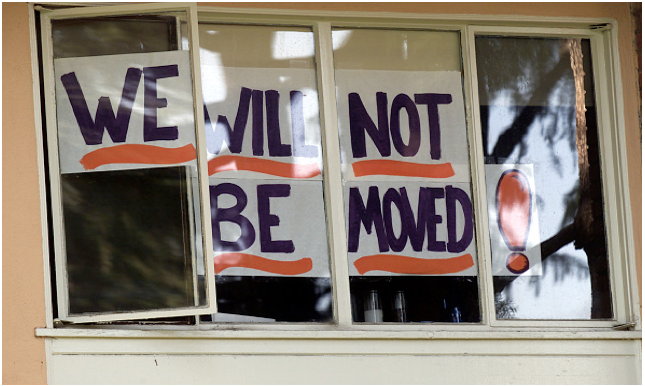CommentsHERE’S WHAT I KNOW--In the years following World War II, Los Angeles was a fast-growing metropolis, an automobile-centric sprawling modern city, attracting new residents seeking a different type of urban living. Architects Heth Wharton and Ralph Vaughn were designing garden apartment complexes in Los Angeles, including Venice’s Lincoln Place, North Hollywood Manor and on thirteen acres of former dairy land in Sherman Oaks, Chase Knolls. Wharton and Vaughn followed the Garden City planning principles, arranging buildings around open courtyards and keeping traffic and storage to the perimeters of the complex.
So many Angelenos have called Chase Knolls home over the years and in 2000, the complex was designated a Los Angeles Historic-Cultural Monument as part of an effort to prevent its demolition. But now, part of the property is at risk.
The city has approved a Tenant Habitability Plan (THP) that allows the developer to knock down existing garages and laundry rooms and remove 138 mature trees to make room for new utility lines to upgrade electricity for future tenants so the landlord may install in-unit washer/dryer and dishwashers, amenities that will not be offered to existing tenants.
By the end of the project, residents’ covered parking will be replaced by an uncovered, unassigned open-air parking space. The change will also compromise the tenants’ storage units, half of the laundry rooms on the 13.5 acre property, as well as the trees and wildlife.
According to a tenant activist, “the developers could move the utility lines over a few feet to save the garages, laundry rooms and trees except they are clearing the area to build six new apartment buildings where the garages and laundry rooms are today. The six buildings will house 141 new units that will not be covered under rent control.”
On top of that, existing residents will get a 10 percent rent increase, based on the total cost of improvements, which is “basically putting the infrastructure in place for the developer to build,” the activist adds.
Many of the existing tenants feel the THP was not properly completed and should have been rejected by the Housing + Community Investment Department for numerous reasons, including all three sections regarding hazardous material abatement, listed as N/A, although two sets of tests submitted by the landlord confirmed the presence of both asbestos and lead in the garages and laundry room, slated for demolition, as well as other issues.
The law mandates disclosure of hazardous materials; leaving out information or lying on the THP form or in testimony is a misdemeanor. Tenant activists have been appealing to Councilmember David Ryu to forward the THP to the City Attorney for investigation.
This past week, prior to a calendared September 27 meeting, trees have been cut down to make room for the electrical updates, some of which contain nests, also a violation of the prohibition against cutting down mature trees during nesting season, which one of the activists brought before Ryu. The activist notes that trees will be continued to be removed through the end of September and possibly into October, despite the EIR indicating that no more than 65 trees would be removed and the DEIR supplement indicating that “it would make every attempt to relocate mature trees … would replace trees that are removed a part of the revised project with the same species.”
The activists will continue to battle against the change to the historic property, changes that will compromise the quality of life for existing tenants. We’ll keep you posted.
(Beth Cone Kramer is a Los Angeles writer and a columnist for CityWatch.)
-cw
Sidebar

 CityWatch Los Angeles
Politics. Perspective. Participation.
CityWatch Los Angeles
Politics. Perspective. Participation.
16
Sat, Nov















